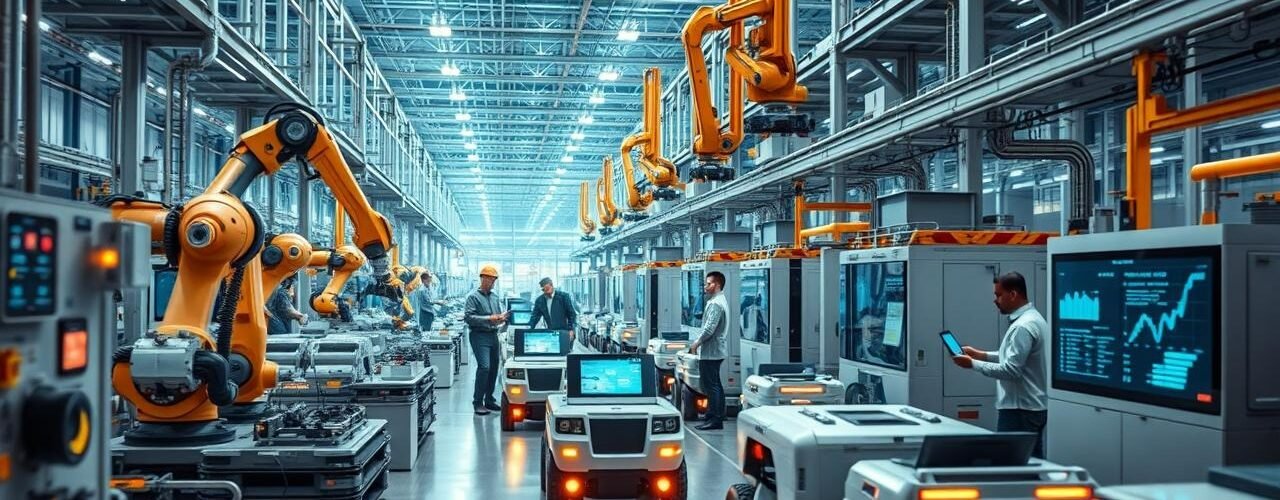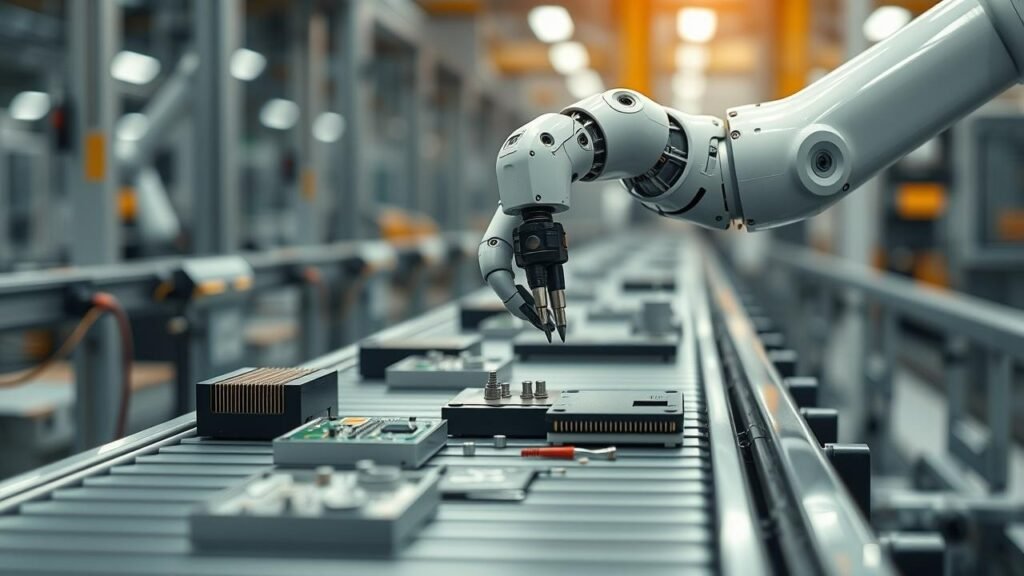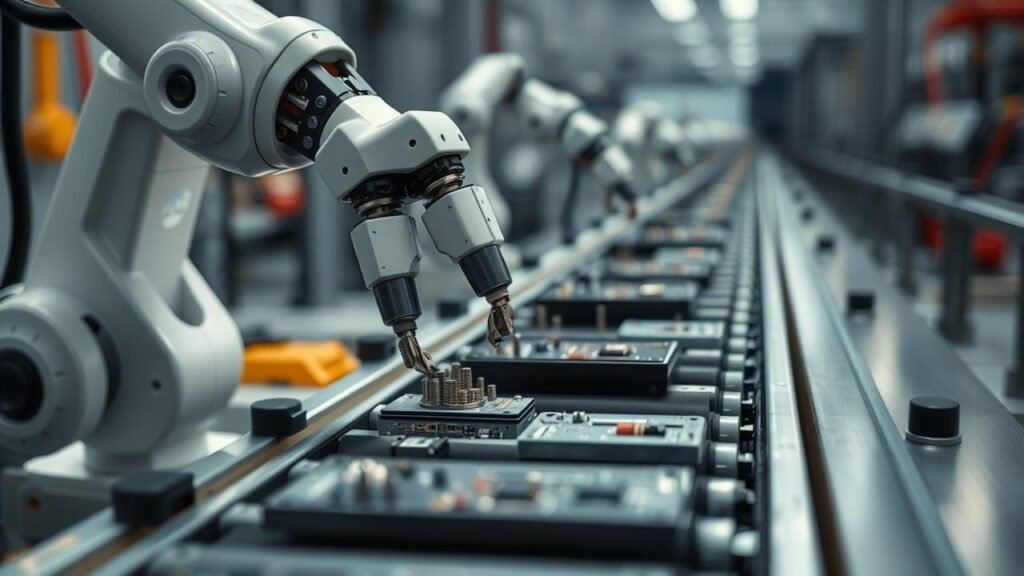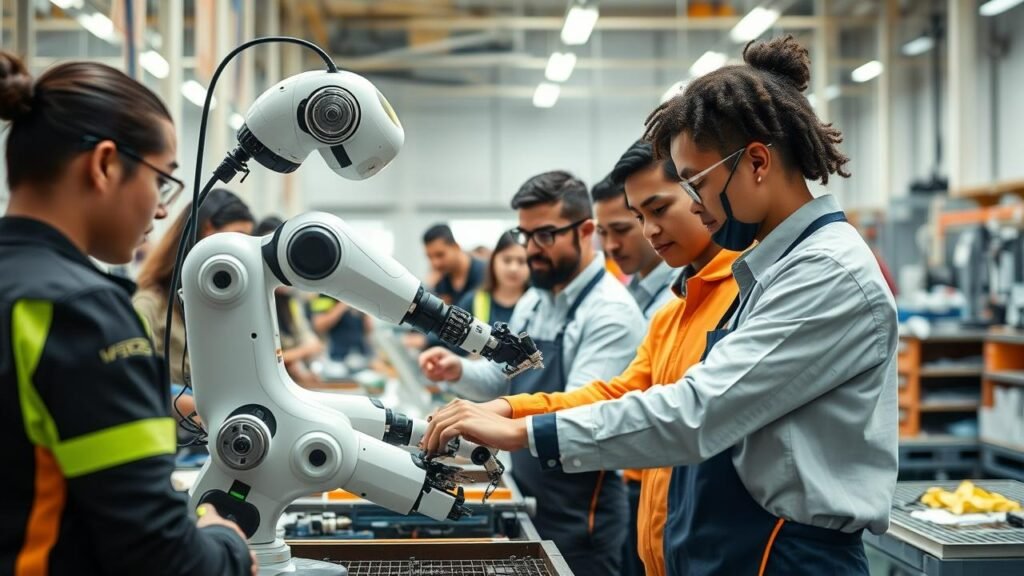The Complete Guide to Industrial Robots: Transforming Modern Manufacturing

Introduction: The Rise of Robots in Factories
The modern factory floor looks dramatically different today than it did just a decade ago. Where human workers once performed repetitive, physically demanding tasks, robots in factories now dominate these environments, working with precision and tireless efficiency. In fact, a recent International Federation of Robotics report revealed that over 3.5 million industrial robots are operating in factories worldwide, with installation rates growing approximately 14% year-over-year. This technological revolution isn’t just changing how products are made—it’s fundamentally reshaping the economics, safety standards, and competitive landscape of global manufacturing.
Whether you’re a manufacturing executive considering automation, an engineer working with industrial systems, or simply curious about how your everyday products are created, understanding the transformative impact of robots in factories has never been more important. In this comprehensive guide, we’ll explore everything from the basic types of industrial robots to their most advanced applications, benefits, challenges, and what the future holds for this rapidly evolving technology.
Table of Contents
What Are Industrial Robots? Understanding the Basics
Defining Modern Factory Robots
Industrial robots are programmable mechanical devices designed to automatically manipulate materials, parts, tools, or specialized devices through variable programmed motions to perform specific manufacturing tasks. Unlike the humanoid robots of science fiction, most robots in factories are specialized machines optimized for specific functions within the production process.
Core Components of Industrial Robots
Every factory robot, regardless of its specific application, consists of several fundamental components:
- Mechanical structure: The physical body of the robot, including arms, joints, and end effectors
- Actuators: Motors or hydraulic systems that create movement
- Sensors: Devices that gather information about the environment and the robot’s position
- Controllers: Computer systems that process information and direct the robot’s movements
- End effectors: Specialized tools attached to the end of a robotic arm (grippers, welding tools, paint sprayers, etc.)
- Power supply: The energy source enabling the robot’s operation
The Six Primary Types of Industrial Robots
- Articulated Robots: Feature rotary joints and can range from simple two-joint structures to complex ten-joint arrangements, offering exceptional dexterity for tasks requiring complex movements.
- Cartesian Robots: Also called gantry robots, these use three linear axes operating at right angles to each other, ideal for pick-and-place operations, assembly, and material handling.
- SCARA Robots: Selective Compliance Assembly Robot Arms excel at vertical assembly tasks with their cylindrical work envelope.
- Delta Robots: Parallel robot designs that use parallelograms in their arms, providing high-speed precision in packaging and food processing.
- Collaborative Robots (Cobots): Designed to work alongside humans with enhanced safety features and intuitive programming.
- AGVs and AMRs: Automated Guided Vehicles and Autonomous Mobile Robots handle material transport throughout factory settings.

The Evolution of Robots in Manufacturing
From Early Automation to Industry 4.0
The journey of robots in factories began with rudimentary automation in the mid-20th century, but has accelerated dramatically in recent decades:
- 1960s: Introduction of the first industrial robot, Unimate, in General Motors assembly lines
- 1970s-80s: Expansion of robotics in automotive manufacturing for welding and painting
- 1990s-2000s: Integration of computer vision and advanced sensors for more complex tasks
- 2010s: Rise of collaborative robots and AI-enhanced capabilities
- Present: Industry 4.0 integration with IoT, cloud computing, and deep learning algorithms
This evolution represents not just technological advancement but a fundamental shift in how manufacturing operates—from isolated robotic cells to fully connected, intelligent systems capable of self-optimization.
Major Milestones in Factory Robotics
The history of industrial robotics features several pivotal developments:
- The first programmable robot patent by George Devol (1954)
- The founding of Unimation, the first robotics company (1956)
- Introduction of the PUMA robot for precise assembly tasks (1978)
- Development of the first truly collaborative robot (2008)
- Implementation of deep learning for robot vision systems (2015)
- Advanced natural language interfaces for robot programming (2020)
Benefits of Implementing Robots in Factory Settings
Productivity and Efficiency Gains
The implementation of robots in factories drives substantial improvements in operational metrics:
- Speed: Modern industrial robots can perform repetitive tasks 4-10 times faster than manual operations
- Consistency: Robots maintain the same level of performance regardless of time of day or duration of operation
- Precision: Many industrial robots achieve accuracy within 0.1mm, far exceeding human capabilities
- Continuous operation: Unlike human workers, robots can operate 24/7 with only minimal maintenance downtime
A manufacturing facility typically sees a 20-30% increase in output after implementing robotic automation, with some specialized applications reporting productivity gains exceeding 50%.
Enhanced Safety and Reduced Workplace Injuries
One of the most significant advantages of factory robotics is their ability to assume dangerous tasks:
- Hazardous environments: Robots operate in extreme temperatures, toxic atmospheres, or around dangerous materials
- Heavy lifting: Industrial robots handle loads from a few kilograms to several tons, eliminating strain injuries
- Repetitive motion: Automation of repetitive tasks reduces repetitive strain injuries among human workers
- Accident reduction: Properly implemented robotic systems with appropriate safety protocols reduce workplace accidents by up to 35%
Quality Improvements and Defect Reduction
The consistency inherent in robotic operations translates directly to product quality:
- Elimination of human error: Programmed robots perform identical operations with every cycle
- Real-time quality monitoring: Modern robots incorporate inspection systems that verify quality during production
- Reduced variability: Statistical process control data shows significantly tighter tolerances in robot-performed operations
- Lower defect rates: Manufacturers typically report 20-40% reductions in defect rates after implementing robotic systems
Economic Advantages and ROI Considerations
While the initial investment in robotics can be substantial, the financial benefits are compelling:
- Labor cost reduction: Depending on the application, robotics can reduce direct labor costs by 40-75%
- Material waste reduction: Precision operations minimize scrap and rework, typically by 15-30%
- Space utilization: Modern robots often require less floor space than conventional equipment
- Energy efficiency: Newer robotic systems consume 10-20% less energy than previous generations
- Typical ROI timeframe: Most industrial robotics implementations achieve positive return on investment within 12-36 months
Major Applications of Robots in Modern Factories
Welding and Joining Operations
Robotic welding represents one of the earliest and most successful applications of robots in factories:
- Arc welding: Robots perform complex weld paths with consistent quality
- Spot welding: Automotive manufacturing relies heavily on robots for precise spot welds
- Laser welding: Ultra-precise joining operations for electronics and medical devices
- Advantages: 30-50% faster than manual welding with 20-40% reduction in materials usage
Material Handling and Logistics
The movement of materials throughout production facilities has been revolutionized by robotics:
- Palletizing/depalletizing: Robots arrange products on shipping pallets or unload incoming materials
- Pick-and-place operations: High-speed selection and positioning of components
- Warehouse automation: AGVs and AMRs transporting materials between workstations
- Container loading/unloading: Robots managing shipping containers and delivery vehicles
Assembly and Manufacturing Operations
Complex assembly tasks increasingly rely on robotic precision:
- Component insertion: Placing electronic components on circuit boards
- Fastening operations: Applying screws, rivets, and other fasteners
- Press-fit assembly: Precisely joining components with interference fits
- Complex sequencing: Managing multi-step assembly processes with multiple components
Surface Finishing and Coating Applications
Surface treatments benefit particularly from robotic consistency:
- Painting and coating: Uniform application of paints, powders, and specialty coatings
- Polishing and deburring: Removing imperfections from manufactured components
- Sanding and finishing: Preparing surfaces for subsequent operations
- Adhesive application: Precise dispensing of glues and sealants
Inspection and Quality Control
Advanced vision systems and sensors enable robots to verify quality:
- Dimensional inspection: Verifying component measurements against specifications
- Surface inspection: Detecting flaws, scratches, or inconsistencies
- Assembly verification: Confirming proper component installation
- Functional testing: Performing operational tests on completed products
Robots and Human Workers: Collaboration in Modern Manufacturing
The Rise of Collaborative Robots (Cobots)
Unlike traditional industrial robots that operate in safety cages, collaborative robots work alongside humans:
- Safety features: Force-limiting technology, rounded surfaces, and advanced sensors
- Ease of programming: Intuitive interfaces allow workers to “teach” robots without coding
- Flexibility: Quick redeployment to different tasks as production needs change
- Accessibility: Lower cost of entry makes automation feasible for small and medium manufacturers
Impact on Manufacturing Employment
The relationship between robots in factories and employment is more nuanced than commonly portrayed:
- Job transformation: While some manual tasks are automated, new roles emerge in robot programming, maintenance, and oversight
- Skill requirements: Manufacturing increasingly demands technical skills to work with automated systems
- Regional variations: Different economies experience varying impacts based on existing industrial base and education systems
- Historical perspective: Previous waves of automation ultimately created more jobs than they eliminated, though with different skill requirements
Training and Skill Development for the Robotic Workplace
As factories adopt more robots, workforce development becomes critical:
- Technical education: Growing demand for robotics technicians and integration specialists
- Upskilling programs: Companies investing in training existing workers to manage automated systems
- Human-machine interface expertise: Specialized knowledge in optimizing robot-human collaboration
- Cross-disciplinary skills: Successful robotics implementation requires mechanical, electrical, and software knowledge

Implementing Robots in Factory Settings: Practical Considerations
Assessment and Planning for Robotic Integration
Successful implementation begins with thorough preparation:
- Process analysis: Identifying operations best suited for automation
- ROI calculation: Detailed cost-benefit analysis considering all factors
- Facility evaluation: Assessing power requirements, floor space, and environmental conditions
- Workflow integration: Planning how robots will fit within existing production systems
Selecting the Right Robotic Solution
With numerous options available, choosing appropriate technology is crucial:
- Application requirements: Speed, payload, precision, and workspace needs
- Flexibility requirements: Fixed automation vs. programmable systems
- Integration complexity: Standalone systems vs. connected solutions
- Total cost of ownership: Initial investment, installation, training, maintenance, and operating costs
Implementation and Integration Challenges
Common obstacles when deploying robots in factories include:
- Legacy equipment integration: Connecting robots with existing machinery
- Data systems compatibility: Ensuring communication between robots and production control systems
- Physical space constraints: Accommodating robots within existing factory layouts
- Staff acceptance: Addressing resistance to change among existing workforce
Maintenance and Optimization Strategies
Maximizing return from robotic investments requires ongoing attention:
- Preventive maintenance schedules: Regular service to prevent costly downtime
- Performance monitoring: Tracking key metrics to identify optimization opportunities
- Software updates: Implementing new capabilities as they become available
- Continuous improvement: Regular review and refinement of robotic operations
Advanced Technologies Enhancing Factory Robots
Artificial Intelligence and Machine Learning Applications
Modern robots in factories increasingly leverage AI capabilities:
- Adaptive control: Self-adjusting parameters based on changing conditions
- Anomaly detection: Identifying unusual patterns that might indicate problems
- Predictive maintenance: Anticipating failures before they occur
- Process optimization: Continuously improving operations through data analysis
Vision Systems and Advanced Sensing
Robots are gaining unprecedented perceptual capabilities:
- 3D vision: Depth perception allowing robots to work with randomly oriented parts
- Multi-spectral imaging: Seeing beyond human visual range for specialized inspection
- Force sensing: Detecting and responding to contact forces during assembly
- Environmental awareness: Monitoring surroundings for safety and process control
Cloud Robotics and Connected Systems
Networking capabilities transform isolated robots into integrated systems:
- Remote monitoring: Real-time performance tracking from anywhere
- Fleet management: Coordinating multiple robots across facilities
- Distributed computing: Leveraging cloud resources for complex calculations
- Over-the-air updates: Deploying new capabilities without production interruption
Digital Twins and Simulation Technology
Virtual modeling accelerates implementation and optimization:
- Process simulation: Testing robotic cells before physical installation
- Performance prediction: Forecasting outcomes of potential changes
- Virtual commissioning: Debugging systems in virtual environments
- Continuous digital representation: Maintaining up-to-date models of physical systems
Challenges and Limitations of Factory Robotics
Technical and Operational Constraints
Despite rapid advancement, several limitations affect robots in factories:
- Complex manipulation: Handling flexible or irregular objects remains challenging
- Cognitive limitations: Understanding context and adapting to unexpected situations
- Integration complexity: Connecting robots with varying communication protocols
- Maintenance requirements: Specialized knowledge needed for servicing advanced systems
Economic Barriers to Adoption
Financial considerations can impede implementation:
- High initial investment: Sophisticated robotic systems often cost $50,000-$200,000 per unit
- Integration expenses: Installation and customization frequently exceed hardware costs
- Expertise acquisition: Hiring or developing qualified robotics personnel
- Upgrade cycles: Keeping pace with rapidly advancing technology
Social and Workforce Concerns
The human dimension presents important challenges:
- Worker displacement anxiety: Fear of job loss creating resistance to automation
- Skill gaps: Shortage of workers qualified to program and maintain robots
- Organizational change management: Adapting company culture to new technologies
- Safety and coexistence: Ensuring proper safeguards when humans and robots share workspaces
The Future of Robots in Factory Settings
Emerging Trends and Technologies
Several developments are shaping the next generation of industrial robotics:
- Soft robotics: Flexible grippers and structures for handling delicate items
- Swarm robotics: Multiple simple robots coordinating for complex tasks
- Advanced materials: Lighter, stronger robot structures with integrated sensing
- Energy efficiency: Self-charging and ultra-efficient power systems
- Natural language interfaces: Programming and directing robots through conversation
Industry 4.0 and Smart Factory Integration
The convergence of multiple technologies is creating the factory of the future:
- IoT connectivity: Robots as nodes in factory-wide information networks
- Big data analytics: Using production data to continuously optimize operations
- Adaptive manufacturing: Real-time production adjustments based on demand
- End-to-end digitalization: Seamless information flow from design through production
Environmental and Sustainability Implications
Robotics is contributing to greener manufacturing:
- Energy optimization: Robots precisely matching energy use to requirements
- Material efficiency: Reducing waste through precision and optimization
- Lifecycle extension: Predictive maintenance extending equipment lifespan
- Facility impact: Smaller factory footprints and reduced resource consumption

Case Studies: Successful Implementation of Robots in Factories
Automotive Industry Applications
The automotive sector remains at the forefront of robotic adoption:
- Tesla’s highly automated production lines: Achieving unprecedented levels of automation in vehicle assembly
- Toyota’s collaborative approach: Balancing automation with human craftsmanship
- BMW’s flexible manufacturing: Adapting robotic systems to produce multiple models on the same line
Electronics Manufacturing Revolution
Consumer electronics production has been transformed by robotics:
- Foxconn’s automation journey: Transitioning from manual assembly to robotic production
- Precision circuit board assembly: Ultra-precise component placement by specialized robots
- Testing and quality assurance: Automated functional testing increasing reliability
Food and Consumer Goods Production
Even traditional industries are embracing robots in factories:
- High-speed packaging operations: Robots handling thousands of products per hour
- Food processing automation: Maintaining hygiene while increasing throughput
- Mixed-case palletizing: Robots assembling store-ready pallets with varied products
Small and Medium Enterprise Success Stories
Robotics isn’t limited to industrial giants:
- Contract manufacturing transformation: Small job shops leveraging robotics for competitiveness
- Collaborative robot implementations: Accessible automation for companies with limited resources
- Robotics-as-a-Service models: Subscription-based solutions reducing capital requirements
Conclusion: Navigating the Future of Factory Robotics
The integration of robots in factories represents one of the most significant technological shifts in modern manufacturing. From improving productivity and quality to enhancing workplace safety and enabling new production capabilities, robotics continues to transform how goods are produced worldwide.
As we’ve explored throughout this guide, successful implementation requires careful planning, appropriate technology selection, and thoughtful integration with human workers. The manufacturers who thrive will be those who view robotics not simply as a cost-cutting measure but as a strategic capability that enables new possibilities.
Whether you’re just beginning to explore automation or looking to expand your existing robotic systems, the journey toward the factory of the future is an ongoing process of adaptation and improvement. By understanding both the capabilities and limitations of industrial robots, you can make informed decisions that position your manufacturing operations for sustainable success.
The question is no longer whether robots will play a significant role in manufacturing—that future has already arrived. Instead, the critical decisions now center on how best to implement these technologies to create factories that are not just more efficient, but more flexible, sustainable, and capable of producing the increasingly sophisticated products that markets demand.
Additional Resources and References
For those looking to deepen their understanding of robots in factories, the following authoritative sources provide valuable insights:
Industry Organizations and Research
- International Federation of Robotics (IFR)
- Robotic Industries Association (RIA)
- Manufacturing Technology Centre (MTC)
- MIT Technology Review Manufacturing Reports
- McKinsey Global Institute Automation Research
Note: These resources are provided for informational purposes only. For specific implementation guidance, consult with qualified robotics integration specialists familiar with your industry and requirements.


